11 Adorable Fuzzy Succulents That You Need to Grow
I absolutely love shopping online for succulents and gardening supplies. If you aren't already saving money by comparing prices online, give it a try! Here are six of my favorite things that I have purchased online as I build my own succulent oasis:
There’s just something so adorable about the combination of furry, fat plants like fuzzy succulents. Their caterpillar-like shape and texture remind me of a warm summer day, even in the midst of a harsh winter. My personal favorite is the ‘panda plant.’
You can add a touch of creativity to your home or garden by growing fuzzy succulents, too. Beautiful and fluffy, it’s hard to imagine they thrive in some of the harshest environments in the world.
Mutually loved by adults and kids, fuzzy succulents are truly fascinating. Running your fingers through a plant with a hair-like feel is almost surreal.
I’ll share all of my research and experience with a variety of fuzzy succulents, and hopefully help you decide why you should be growing them as well.
Why Are Some Succulents Fuzzy?
Some succulents are fuzzy to protect them from extreme light. Trichomes that look like hairs have developed to help them survive. They protect the plant against the sun, loss of moisture, pathogens, and drought.
Each hair provides a bit of shade to the plant, protecting it against the sun’s rays. Acting much like an umbrella or hat on a sunny day, the hairs have a cooling effect on the succulent. Long white hairs are a sign that the succulent is in a harsh environment and may need to be moved inside or to a shadier location.
11 Fuzzy Succulents to Add to Your Garden or Windowsill
Fuzzy succulents come in all shapes and sizes, and there are hundreds to choose from. I’ve put together a list of some of the best fuzzy succulents you can grow at home.
1. Kalanchoe Tomentosa ‘Panda Plant’
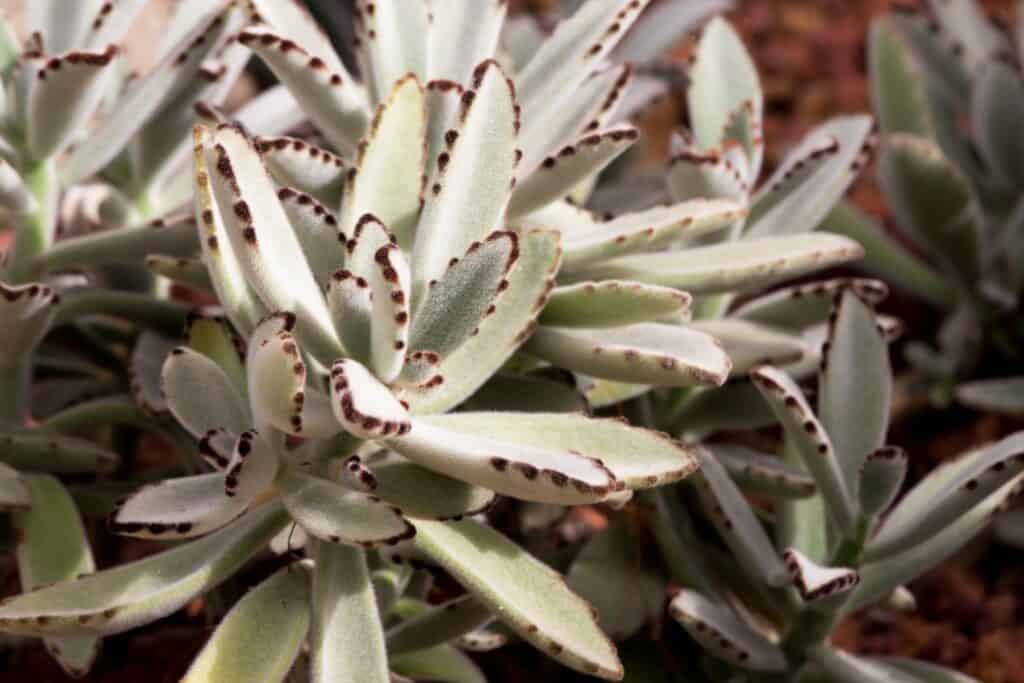
Found on the mystical island of Madagascar, Kalanchoe Tomentosa is a popular succulent with fuzzy leaves and brown edges. Affectionately known as the ‘Panda Plant’ due to its coloring, the fluffy succulent is particularly popular with children.
Tomentosa translates to ‘densely wooly’, an acknowledgment of its fur-like texture.
In the wild, the Panda Plant will grow up to a height of three feet with a woody base. Don’t fret though, it will only grow to the size of the pot if growing inside your home – approximately a couple of feet in height and diameter.
2. Echeveria ‘Doris Taylor’
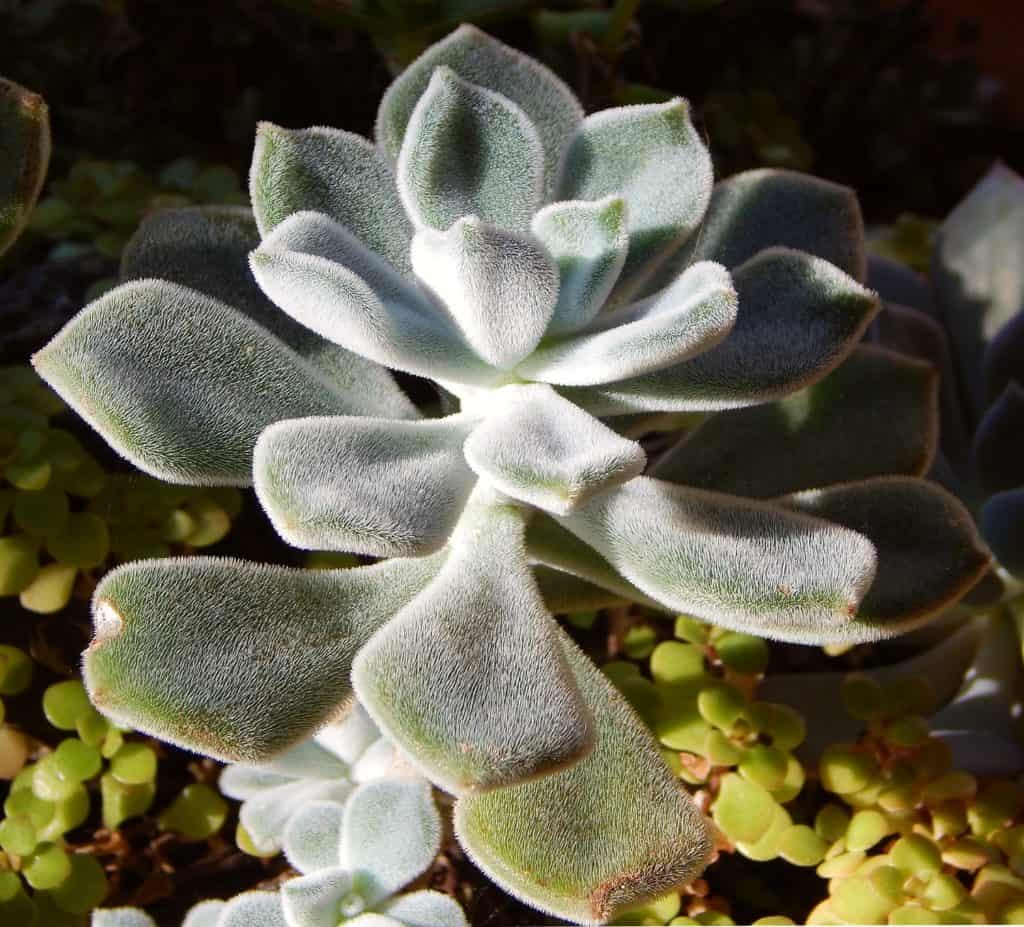
Beautiful and rare, echeveria ‘Doris Taylor’ is a low-maintenance fuzzy succulent ideal for beginner gardeners. It is a cross between Echeveria pulvinata and Echeveria setosa. Glistening silver hairs cover pale blue-green leaves that turn a vibrant red color at the tips in bright light (commonly named the Woolly Rose).
Found between spring and fall, the Doris Taylor plant blooms into a magnificent yellow flower with red shading. After the fall, the lower leaves will begin to fall off and rot. It’s important to remove the rotting leaves from the base of the plant as the rotting can spread to healthy leaves.
3. Cotyledon Tomentosa ‘Bear’s Paw’
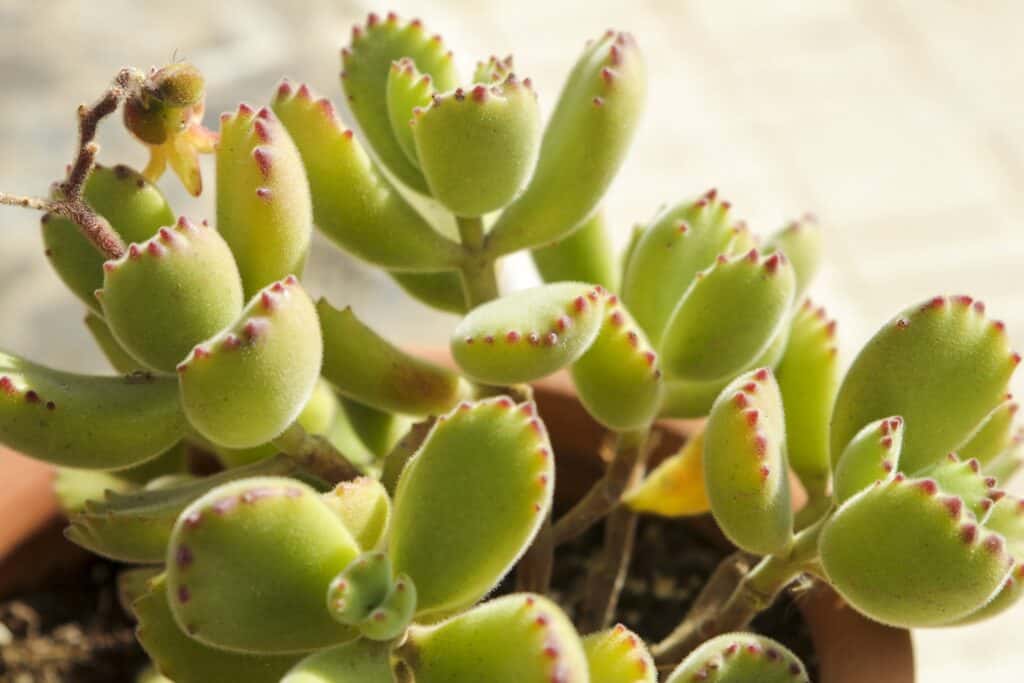
One of my favorite fuzzy succulent names on this list – ‘Bear’s Paw’ derives its name from its red-toothed edges that resemble a bear’s claw. The velvet-like coating and gray-greenish coloring will be an awesome addition to any living space.
The Cotyledon Tomentosa requires at least 6 hours of sunlight per day. During spring, a large bell-shaped orange flower will bloom that can reach 12 inches (30.5 cm) in height.
Bear’s Paw is a very fragile succulent that can die if left in temperatures that fall to 30°F (-1°C).
Related: Succulent Sunburn: How to Treat, Heal, and Avoid Sun Damage
4. Crassula Mesembryanthemoides ‘Tenelli’
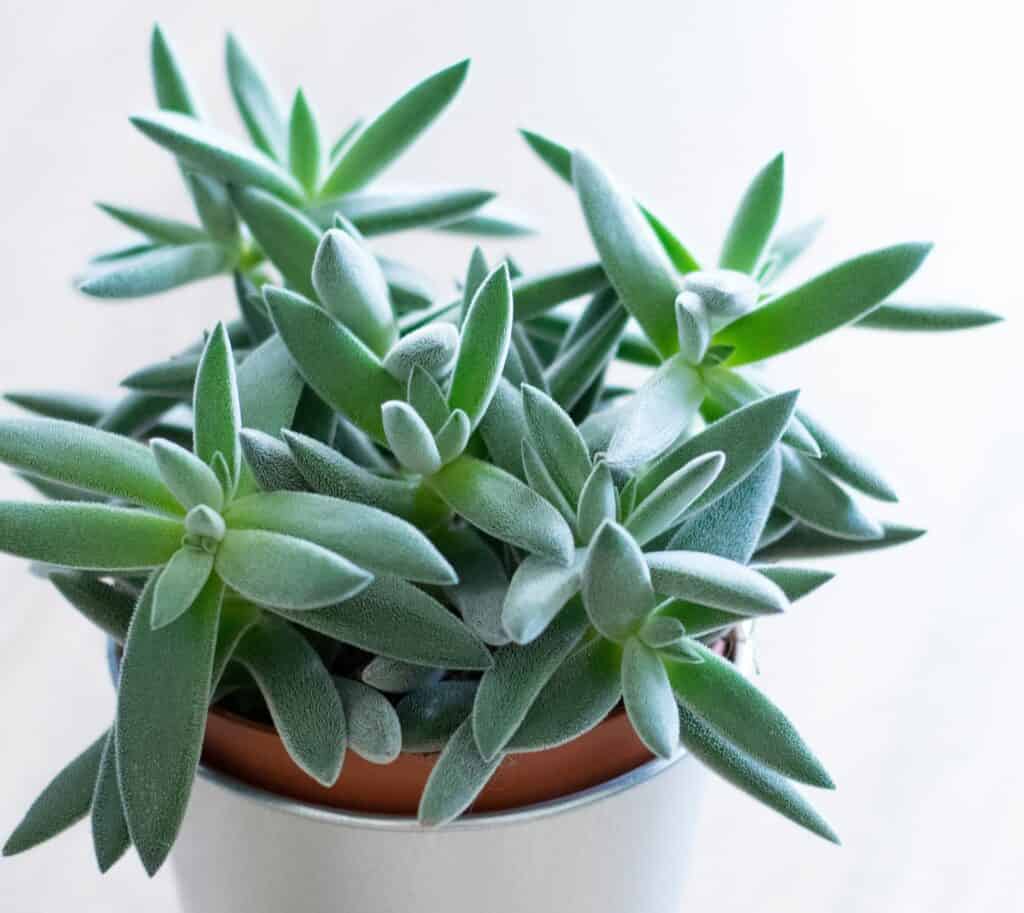
Crassula Mesembryanthemoides is a succulent with white fuzzy leaves that hails from South Africa. Distinctive teardrop-shaped leaves that grow in pairs adorn the Tenelli succulent that grows on a wooden stem.
Covered in white hairs, they will turn a red/ brownish color as the succulent ages.
Expect your Tenelli to reach a height of 12’’ (30.5cm). For optimal growth, we recommend keeping your Crassula Mesembryanthemoides at a south-facing window if growing indoors.
5. Kalanchoe Beharensis ‘Felt Bush’
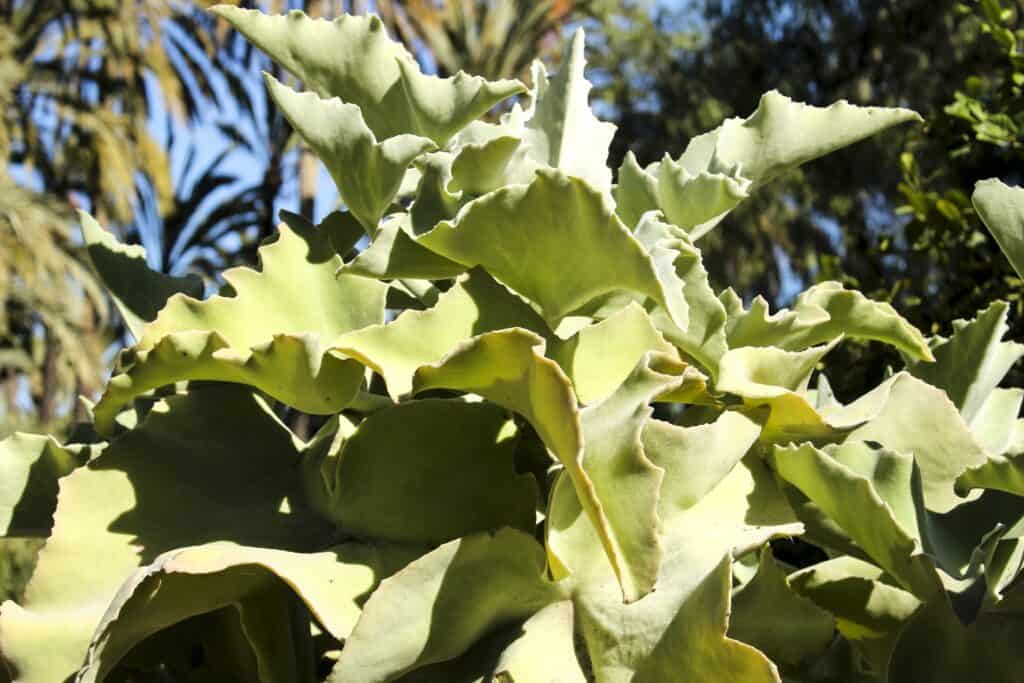
Reaching an impressive height of 12 feet in its native Madagascar, Kalanchoe Beharensis is a statuesque addition to your garden. Outside its natural environment, the average height the Felt Bush will grow is 3 to 4 ft tall, with a width of 2 ft.
Growing slowly, the Felt Bush produces large triangular-shaped leaves with long stems that are covered in brownish hairs. After maturing, many small urn-shaped flowers blossom with a yellowish-green color. Flowers aren’t guaranteed to blossom outside the Kalanchoe Beharensis native habitat, but if they do it will be in spring.
At the maturing stage, the upper part of the leaves becomes a bronze color with a light-gray tone on the undersides.
Related: Stunning Black Succulents to Spruce Up Any Space
6. Echeveria Setosa
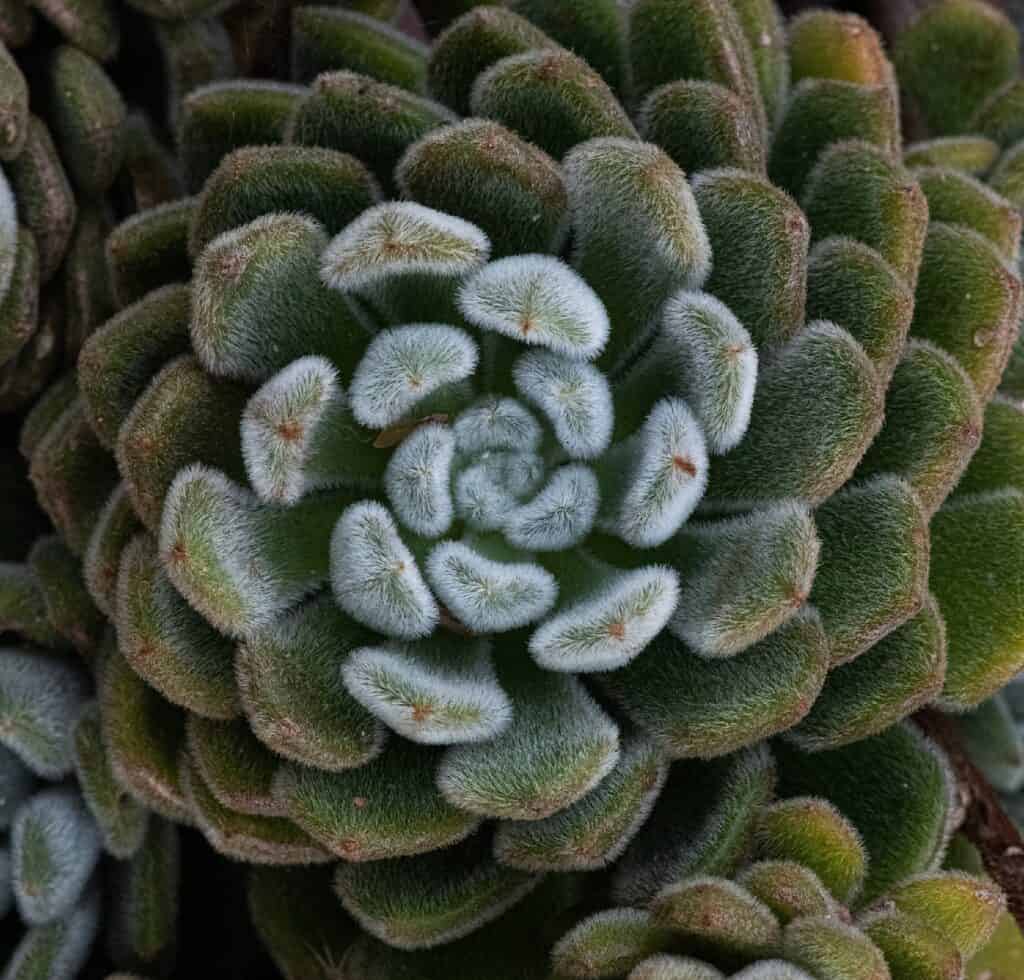
Echeveria Setosa (the Mexican firecracker) is a popular houseplant with many varieties to choose from. The white hair-covered succulent is very easy to maintain and grow. It is a perfect addition to any windowsill or shelf without compromising room with its growth of only 12 inches.
The green spoon-shaped leaves blend beautifully with the yellow and red urn-shaped flowers that blossom in the summer. Rosettes that appear are only 3 cm in width and won’t take up much extra space.
7. Echeveria ‘Pulv-Oliver’ (Red Echeveria)
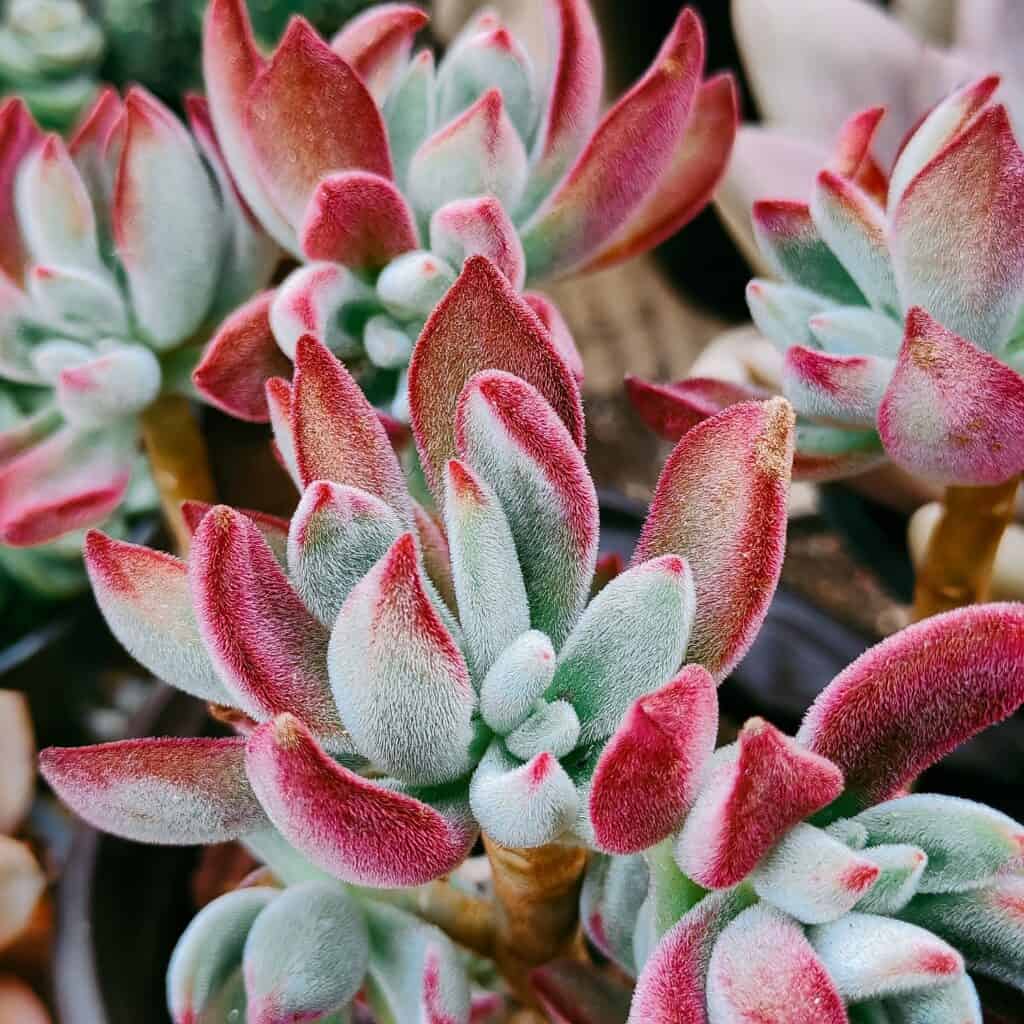
Echeveria ‘Pulv-Oliver’ (Red Echeveria) is an attractive succulent that belongs to the Crassulaceae family. A hybrid of two succulents, Echeveria Pulvinata and Echeveria Harmsii, the combination results in a magnificent orange/ yellow flower when blooming.
Lovely light-green leaves with red tips covered in white hairs create a beautiful plant that will look great in any setting.
Red Echeveria grows to 1 ft in height and the leaves reach approximately 1 foot in diameter. If you keep your Echeveria ‘Pulv-Oliver’ on your windowsill, we recommend turning it every few hours so each side gets some sunlight for optimal growth.
Related: Fast-Growing Succulents for Lush Windowsills and Gardens
8. Senecio Haworthii ‘Cocoon Plant’ (Wooly Senecio)
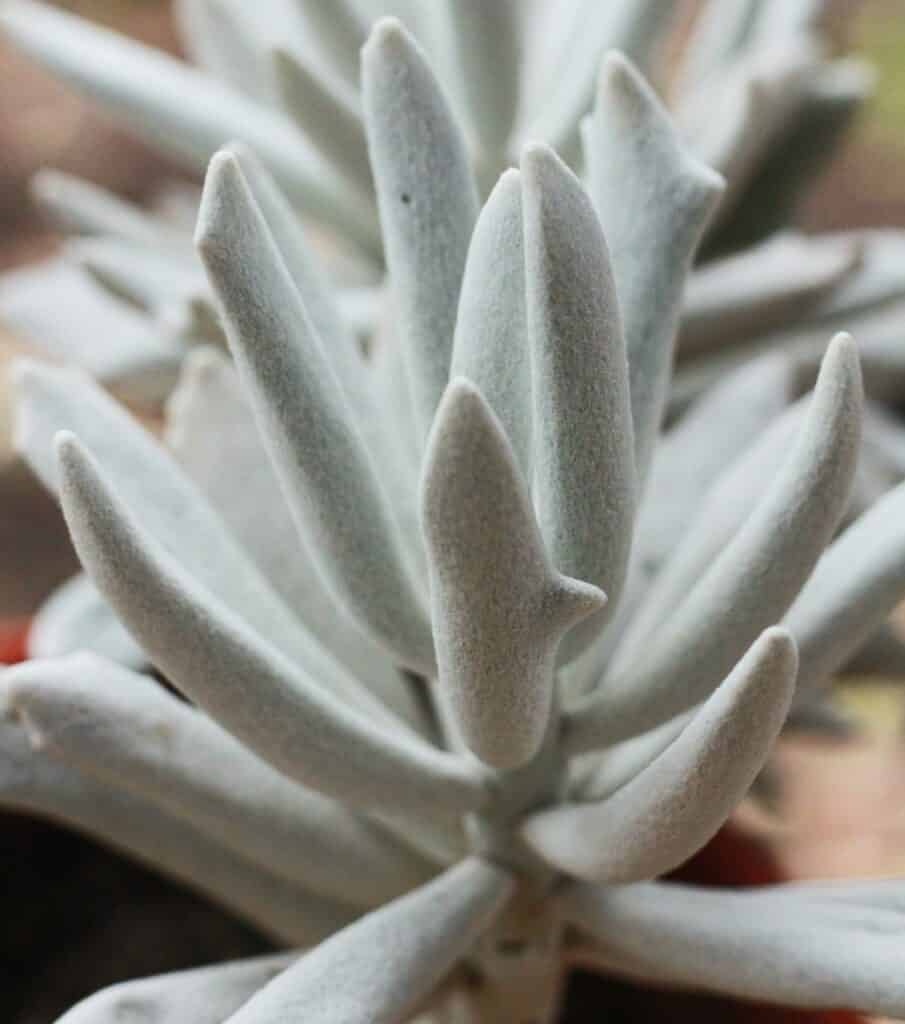
The rare Senecio Haworthii ‘Cocoon Plant’ has cocoon-shaped white leaves that are wonderful to inspect. Small shrubs grow out the wooden stems covered in white hairs.
Fuzzy succulent identification can be made quite easily when you see the Wooly Senecio.
Senecio Haworthii was first mentioned in Miscellanea Naturalia in 1803 by Adrian Hardy Haworth – an English botanist. The succulent can grow to an estimated 1 ft tall and 2 ft wide. In its natural habitat, it can grow much taller.
9. Kalanchoe Beharensis (Elephant Ear)
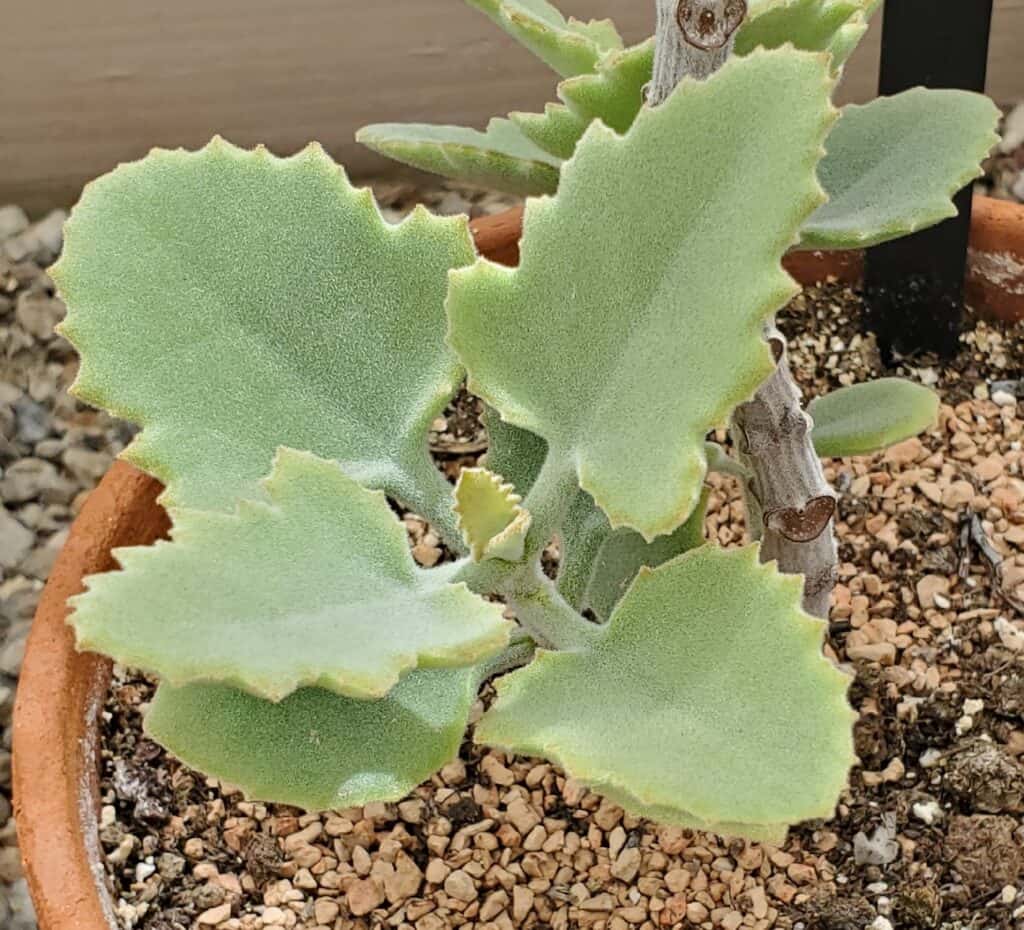
Originating in Madagascar, the Kalanchoe Beharensis (Elephant Ear) is a perfect plant for beginners. Easy to maintain and grow in a container, little maintenance is required for this succulent to thrive.
Large fleshy leaves with brown hairs that provide a soft feel adorn the Elephant Ear. The olive-green leaves grow in pairs at a 90-degree angle to each other.
It grows to an average height of 18-30 inches (46-76cm) in a home setting but can reach heights of nearly 10 feet in its natural habitat! Growing is best done in a mix of sunshine and shade.
10. Delosperma Echinatum (Pickle Plant)
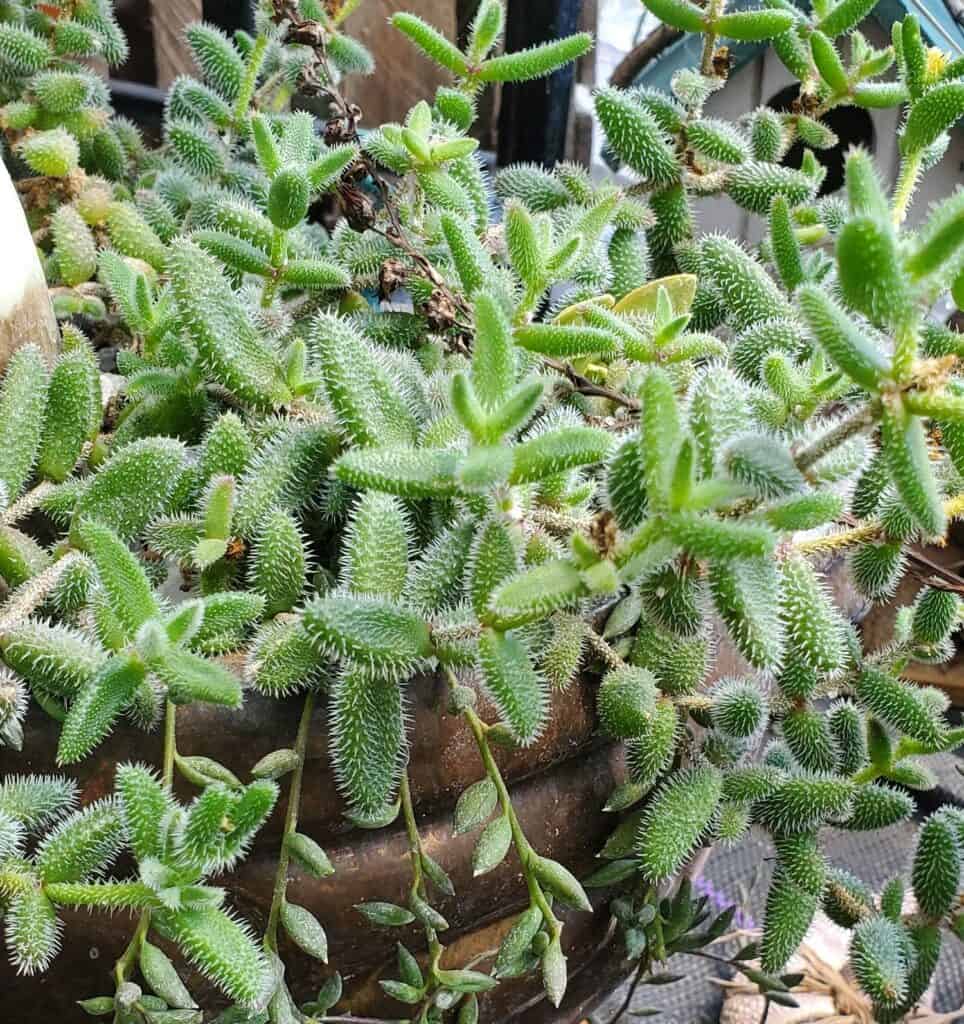
Another succulent with fuzzy leaves is the Pickle Plant. Spine-like hairs look like they will hurt to touch, but are surprisingly soft. Uniquely, Delosperma Echinatum maintains its evergreen color throughout the year.
Bright green leaves are paired on each stem that can reach up to 18 inches (45 cm). Each leaf is wide and fleshy, growing up to 1 inch (2.5 cm) long. Yellow and white flowers bloom in late winter to fall with the peak time being in spring.
11. Sempervivum (Dream Catcher)
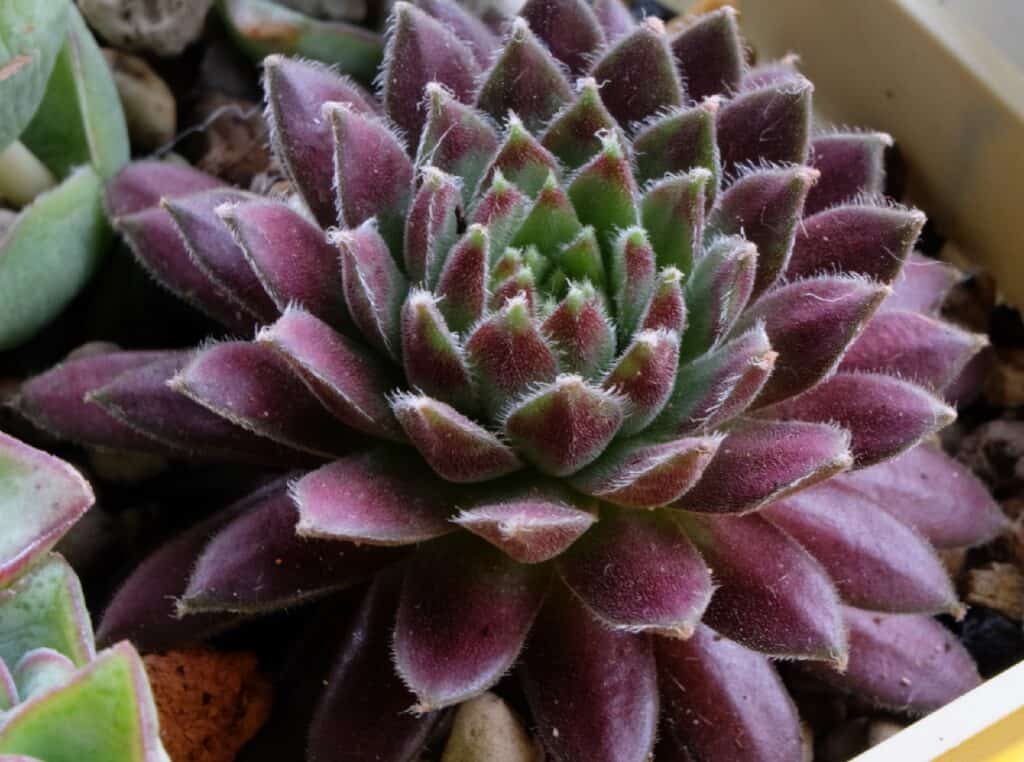
Sempervivum is a fascinating type of succulent that derives its name from ‘always alive’. Throughout the year, don’t be surprised to see the colors changing. In the hotter months, reddish to burgundy leaves will be displayed, and in winter the leaves will turn dark green with tints of purple.
Commonly referred to as hens and chicks, this succulent dies out after its flowers bloom, but is quickly replaced by the younger parts of the plant.
Originating in North America, Dream Catchers can be found in the wild in rocky hard places. But, they do still make for a great house plant. growing to an average height of 8 inches.
Related: Best Succulents for Full Sun (Drought Tolerant Species)
Care Tips For Fuzzy Succulents
Fuzzy succulents require special care and you need to follow some basic guidelines for them to thrive outside or indoors. Here are a few tips for looking after your fuzzy succulent;
Don’t Water the Leaves
Watering the leaves of a fuzzy succulent can cause them to rot. The droplets of water can act as small magnifying glasses, essentially burning off the hairs if in a hot environment. Rainwater is the best water for fuzzy succulents, as it doesn’t contain any minerals.
Water the Soil Only When Dry
Poor watering habits are the most common cause of death in succulents. Make sure the soil is bone dry before you water them. A plant pot with good drainage and fast-draining succulent soil is highly recommended.
Keep in Optimal Conditions
Fuzzy succulents love warm temperatures and thrive in temperatures ranging from 60 – 80°F (15 – 26.6°C). Some fuzzy succulent types even live in temperatures up to 90°F (32.2°C).
Providing plenty of light is the key to keeping your fuzzy succulent healthy.
Related: How to Start a Greenhouse for Succulents (In- or Outdoors)!
Start Your Fuzzy Succulent Collection Today
Fuzzy succulents are a true joy for any gardener. The easy-to-maintain plants have a wide variety of options available, so you will be sure to find one to suit your home or garden.
Running your fingers through the hairy leaves and stems of your fuzzy succulent is an awesome feeling. Not to mention, some of them have cool and fun names like Pickle Plant, Elephant’s Ear, and Bear’s Paw. Procure one or more of these for yourself and enjoy the warmth they bring to your life!